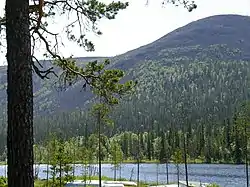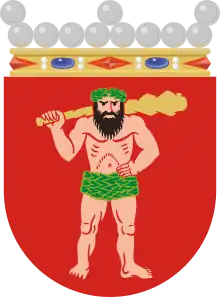Kolari
Kolari is a municipality of Finland at the Swedish border, which follows the Torne River, the longest free-flowing river in Europe.
Kolari | |
|---|---|
Municipality | |
| Kolarin kunta Kolari kommun | |
 Lake Kesänki at Ylläs | |
 Coat of arms | |
 Location of Kolari in Finland | |
| Coordinates: 67°19′50″N 023°46′40″E | |
| Country | |
| Region | Lapland |
| Sub-region | Fell Lapland |
| Charter | 1867 |
| Government | |
| • Municipal manager | Heikki Havanka |
| Area (2018-01-01)[1] | |
| • Total | 2,617.87 km2 (1,010.77 sq mi) |
| • Land | 2,558.61 km2 (987.88 sq mi) |
| • Water | 59.15 km2 (22.84 sq mi) |
| • Rank | 21st largest in Finland |
| Population (2023-09-19)[2] | |
| • Total | 3,940 |
| • Rank | 194th largest in Finland |
| • Density | 1.54/km2 (4.0/sq mi) |
| Population by native language | |
| • Finnish | 97.2% (official) |
| • Swedish | 0.7% |
| • Sami | 0.1% |
| • Others | 2% |
| Population by age | |
| • 0 to 14 | 15.2% |
| • 15 to 64 | 57.6% |
| • 65 or older | 27.1% |
| Time zone | UTC+02:00 (EET) |
| • Summer (DST) | UTC+03:00 (EEST) |
| Website | www.kolari.fi |
It is located in the region of Lapland. The municipality has a population of 3,940 (19 September 2023)[2] and covers an area of 2,617.87 square kilometres (1,010.77 sq mi) of which 59.15 km2 (22.84 sq mi) is water.[1] The population density is 1.54 inhabitants per square kilometre (4.0/sq mi).
Neighbouring municipalities are Muonio, Pello, Kittilä, Rovaniemi in Finland and Pajala Municipality in Sweden.
The municipality is unilingually Finnish.
Kolari railway station is the northernmost station in Finland.
Ylläs, one of the most popular ski resorts in Finland, is located in Kolari. The area also features the country's largest bog with a thousand-year-old forest.
History
The area was originally inhabited by Sámi people.
The first permanent settler in the area was a Savonian named Pekka Kolari, arriving in the area in the early 1580s. He originated from Konnevesi, which was a part of the Rautalampi parish at the time. The island named Kolarinsaari near the village of Istunmäki was likely his original home, as the Savonian surname Kolari originates from the same island.
The area of Kolari was a part of the Pajala parish, which is in modern Sweden. Kolari started growing in the 17th century due to the nearby Kengis (Köngäs) ironworks established in 1644. Kolari was home to many skilled blacksmiths. Charcoal, tar and chalk were produced and delivered to Tornio.
After Russia gained Finland in 1809, it was transferred to the Turtola parish, modern Pello. As the winter market could no longer be held in Kengis due to the new border, they were held on the island of Kolarinsaari in the Tornio river. Kolari became a chapel community in 1856 and a separate parish in 1894.
See also
References
- "Area of Finnish Municipalities 1.1.2018" (PDF). National Land Survey of Finland. Retrieved 30 January 2018.
- "Finland's preliminary population figure was 5,587,841 at the end of August 2023". StatFin. Statistics Finland. Retrieved 30 September 2023.
- "Demographic Structure by area as of 31 December 2022". Statistics Finland's PX-Web databases. Statistics Finland. Retrieved 6 September 2023.
- "Population according to age (1-year) and sex by area and the regional division of each statistical reference year, 2003–2020". StatFin. Statistics Finland. Retrieved 2 May 2021.
- "SuomalainenPaikannimikirja_e-kirja_kuvallinen.pdf" (PDF). kaino.kotus.fi (in Finnish). p. 172. Retrieved August 24, 2022.
- "Kolarin tarina - Kolarin kunta". kolari.fi (in Finnish). Retrieved August 24, 2022.
External links
![]() Media related to Kolari at Wikimedia Commons
Media related to Kolari at Wikimedia Commons
- Municipality of Kolari – Official website (in Finnish)
- Archived English version of the official website's homepage
- Ylläs webpage
 Kolari travel guide from Wikivoyage
Kolari travel guide from Wikivoyage
